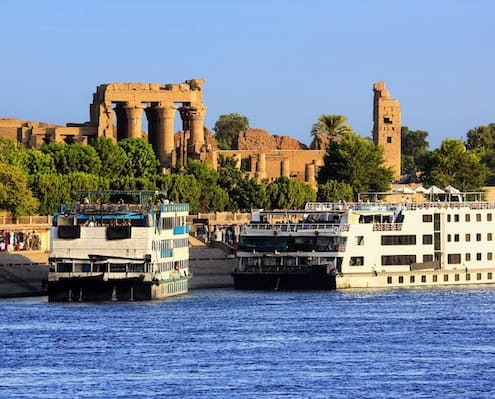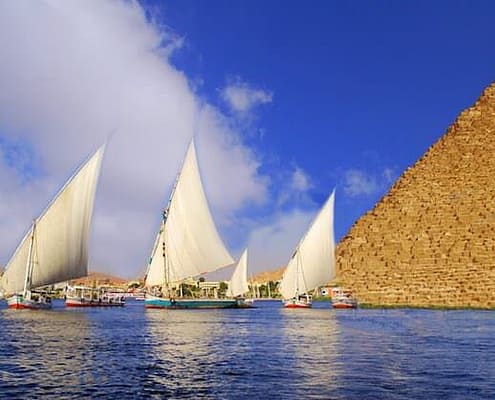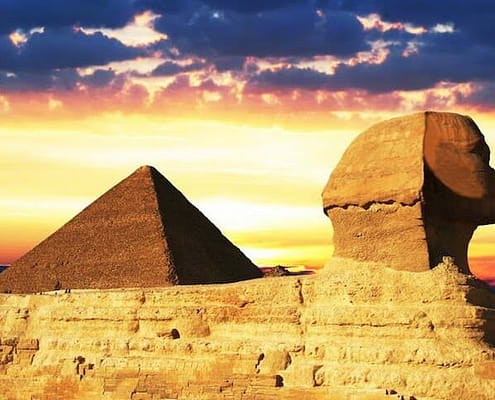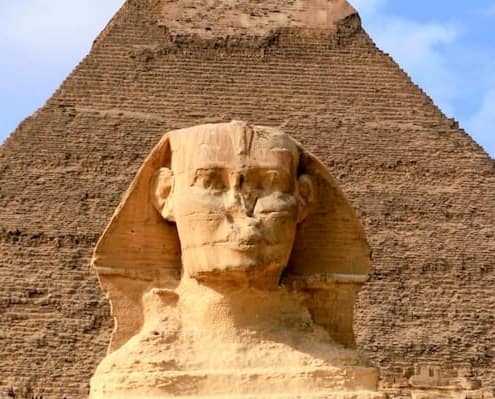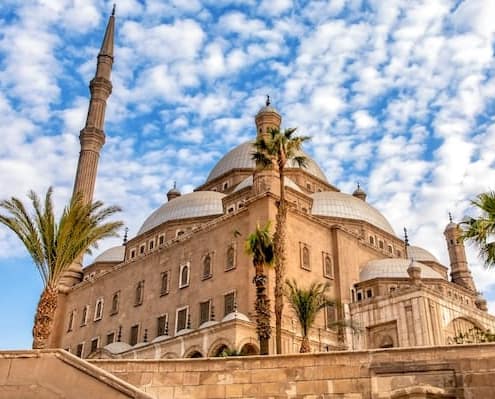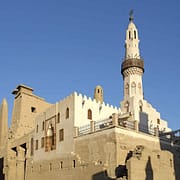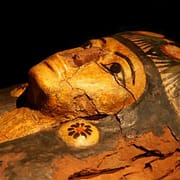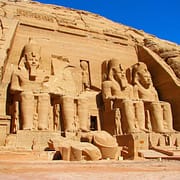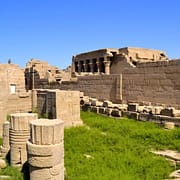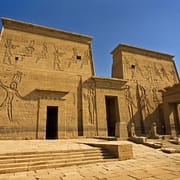Luxor Temple – An Ancient Temple Of Pharoah Amenophis III
Luxor Temple is one of six ancient temples found in the vicinity of Luxor. It was built on the East Bank of the Nile River by Amenhotep III for worshiping the gods Amun, Chons and Mut. It is one of Egypt’s most famous archaeological sites and one of the most famous ancient Egyptian Temples, and one which features in many of our Egypt tour packages, and also in nearly all of our Nile River cruises.
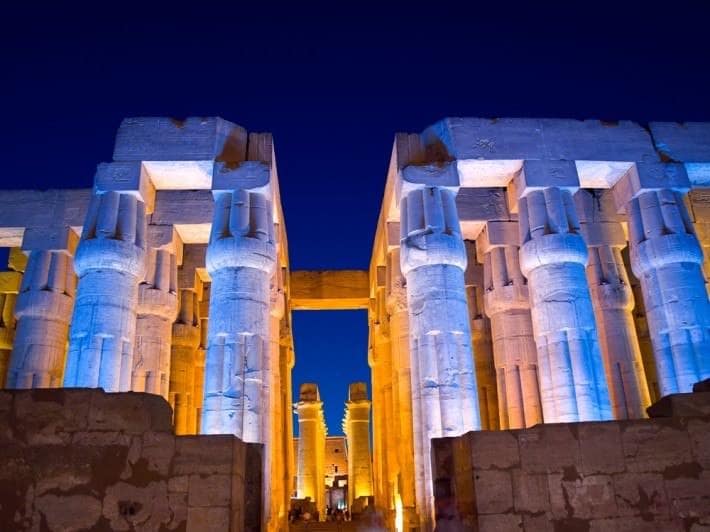
Luxor Temple by night – Luxor, Thebes.
Who was Pharaoh Amenhotep III
Amenhotep III was an ancient Egyptian pharaoh who reigned from 1391 to 1353 BCE during the 18th dynasty of Egypt’s New Kingdom. He was the son of Thutmose IV and his queen, Mutemwia, who was probably a minor wife. Amenhotep III was crowned at the age of twelve and ruled for nearly four decades.
Amenhotep III was known as a great builder who commissioned many construction projects throughout Egypt. His most famous construction project was the temple complex at Luxor, which still stands today as a testament to his power and wealth. He also commissioned the construction of the Colossi of Memnon, a pair of massive stone statues that still stand today.
Amenhotep III was also known for his diplomatic skills. He formed alliances with other powerful kingdoms and helped maintain peace throughout the region during his reign. He also maintained good relations with the priesthood and was a patron of the arts.
One of the most interesting aspects of Amenhotep III’s reign was his connection to the god Amun. He was known as a “Son of Amun” and built many temples to Amun throughout Egypt. He also believed that he was a direct descendant of the god, which helped legitimize his rule.
Amenhotep III’s reign was considered a golden age of Egypt. He ruled during a time of great prosperity and stability, and his legacy can still be felt today in the many monuments and temples he commissioned.
Luxor Temple – One Of Luxor’s Premium Attractions
Along with Karnak Temple, the Temple of Luxor is one of the most famous ancient Luxor tourist attractions and is placed firmly on the tourist trail in Egypt, attracting many thousands of visitors each year. It is one of six ancient famous temples in and around the city of Luxor in Upper Egypt, in the area that was once home to the ancient city of Thebes. The temple was initially built for religious rites to the gods Amun, Chons and Mut.
A Brief History Of Luxor Temple
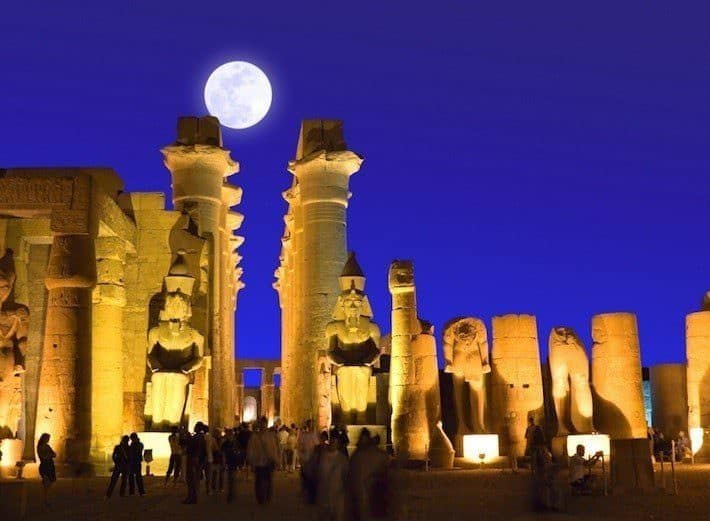
Full moon over Luxor Temple
Luxor temple was built in 1400 BCE during the reign of Amenophis III and was known to the Egyptians as the Southern Sanctuary. Later, Tuthmosis III and Alexander the Great both built chapels on the grounds, located just to the rear of the main temple. The temple, as well as the other structures at the site were all built from Nubian sandstone that was transported to the site from quarries in southwestern Egypt. During the Roman period, the temple was used almost exclusively as a fortress as well as serving as the headquarters of the Roman Government.
The Temple Colonnade and Hypostyle Hall
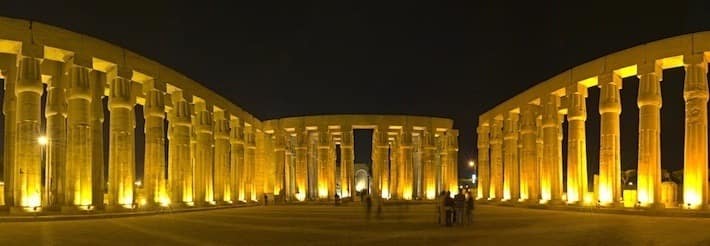
Hypostyle Hall Panorama, Luxor Temple
One of the most awe-inspiring features at Luxor Temple is it imposing colonnade comprising a total of 14 columns that are topped with papyrus shaped capitals. Each column is roughly 23 meters high, with a circumference of around 10 meters. Both sides on the colonnade are enclosed with masonry walls that are covered with reliefs showing scenes relating to the Opet festival. The colonnade, along with the decorated walls was completed during the reign of King Tutankhamun and King Horemheb.
Moving past the colonnade, visitors will pass through a large courtyard lined with more large pillars as they make their way to the vast hypostyle hall, which again, is home to another 32 massive columns. From here visitors can move on to view the inner part of the temple that includes four antechambers and ancillary rooms, together with the Sanctuary of the Sacred Barque which is found in the innermost room. Interestingly, records show that Alexander the Great completely rebuilt the chapel during his reign.
Significance Of The Luxor Temple Ceremonies
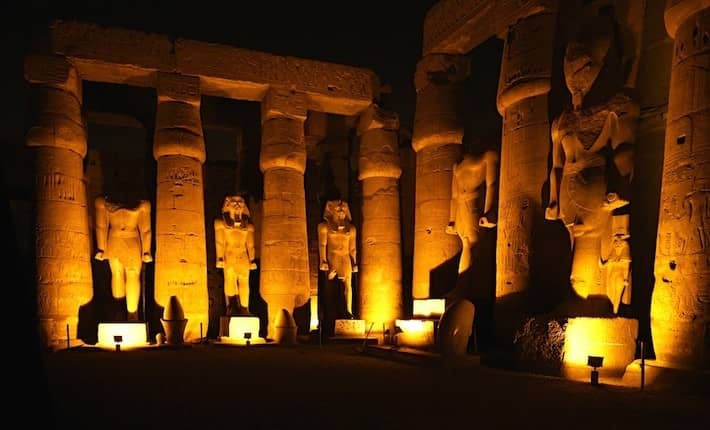
Columns and statues, Luxor Temple by night
The ancient Egyptians are well known for their many different ceremonies, but it should be said that those held at Luxor Temple were not only incredibly important, but also very complex in terms of religious symbolism. In ancient times, Luxor Temple also served as a shrine where people could worship the divine and immortal portion of the pharaoh, known as the royal “ka”. This was essentially a symbol that was representative of the legitimacy of a pharaoh’s power, and as such, it was not restricted to any one individual pharaoh.
Many historians and archaeologists consider the temple and its colossal statues to be one of the New Kingdom’s most remarkable architectural achievements. No matter how many pictures you see, and no matter how many words you read, you can’t really appreciate the magic of this attraction until you actually visit.
Avenue of Sphinxes
Besides Luxor Temple, one of the most impressive construction projects commissioned by Amenhotep III was the Avenue of the Sphinxes. This avenue was a 2-mile long pathway that connected the temple of Karnak to Luxor temple. It was lined with hundreds of sphinx statues that had the head of a human and the body of a lion, symbolizing strength and wisdom.
The Avenue of the Sphinxes was not just a decorative feature, it also had a practical purpose. It served as a processional way for priests and royalty to travel between the two temples during religious festivals and annual festivals, including Opet festivals.
The avenue was also a symbol of the pharaoh’s power and wealth, showcasing the artistic and architectural achievements of his reign. Today, visitors can once again walk along the Avenue of the Sphinxes and appreciate the impressive scale and beauty of this ancient construction project.
Other Famous Nearby Archeological Sites To Visit
Luxor is quite literally overflowing with ancient history and is home to numerous ancient monuments. Apart from Luxor Temple, anyone visiting Luxor city should also make a point of visiting the Karnak Temple complex, the Valley of Kings, Queen Hatshepsut’s mortuary temple, and the Colossi of Memnon, two giant statues that stand at the entrance of what was once the mortuary temple of Amenhotep III.
Visiting Luxor Temple
Ideally, one should plan on spending at least two days in Luxor in order to the see all of the best sites. However, if you are based in Cairo and you only have a limited amount of time to spare, then your best option would be a Luxor private full-day tour. a full-day tour will typically include an early morning flight to Luxor, a full day of sightseeing, and then a late afternoon/early evening flight back to Cairo.
For those who have a bit more time to spare, an overnight sleeper train ride from Cairo to Luxor is also a great option worthy of consideration.
Most good quality Luxor day tours will feature the area’s top five pharaonic sites:
- Luxor Temple
- Karnak Temple
- Valley of the Kings
- Hatshepsut Temple (Deir El-Bahari)
- Colossi of Memnon
Luxor Hot Air Balloon Rides
The best way to experience the real magic of Luxor’s temples is in the company of a professional Egyptologist guide. With that having been said, anyone with the time and resources should also definitely consider an early morning hot air balloon ride over Luxor’s ancient sites, including Luxor Temple, the Temple of Karnak, the Valley of Kings, the Temple of Queen Hatshepsut and etc.
3-Night Luxury Nile Cruise
While it may not be your cheapest option, the best way to experience the beautiful temples and tombs of Luxor is by way of a Nile River cruise. These cruises also include a number of other tours, in Aswan, Kom Ombo and Edfu. If a cruise is beyod your budget, then a private full-day Luxor tour would be your next best option.
If you’ve booked or intend booking one of our Nile cruises from Luxor to Aswan or from Aswan to Luxor, you are guaranteed to see the amazing Luxor Temple featured in your Egypt tour package itinerary.
Design Your Custom Egypt Tour
Explore Egypt your way by selecting only the attractions you want to visit
Egypt Travel Information
Last Updated on May 6, 2025


